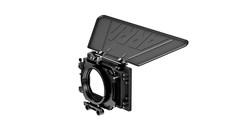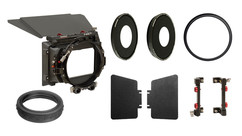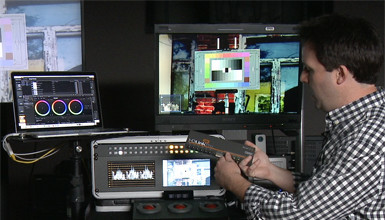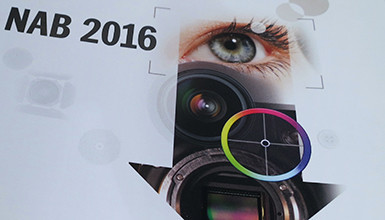While it utilizes a full frame sensor (24mm x 36mm), the 1D C can also shoot in a Super 35 crop mode, while the 4K mode utilizes an APS-H sized crop. Many of the available accessories are shared amongst other HDSLR's, but the tall form factor of the 1D C means there will be some differences. In this article, we present the many different lenses & accessories that can be used with this camera.
Lens Adapters | Lenses | Mattebox, Follow Focus and Shoulder Rigs | Recorders | Power Options | Recording Media | Viewfinders
Lens Adapters
The EOS-1D C utilizes Canon's EF lens mount, the same mount found on all of the Canon EOS bodies as well as the Cinema EOS line (C100, C300, C500). There are several lens adaptor options, but here are some of the more popular solutions.
Novoflex EF to Nikon F adapter
The Novoflex Canon EF to Nikon adapter allows Nikon F-mount lenses to be attached to the camera. This adapter only works with lenses with built in aperture rings, so it is not recommended for "G" series lenses. It will accommodate full frame FX lenses as well as DX (APS-C) sized lenses. It can be used with all Zeiss ZF.2 lenses, since those lenses have built in aperture rings.
Novoflex EF to Nikon F adapter with aperture ring
For those lenses without a built in aperture ring (Nikon "G" series), this version of the Novoflex adapter is able to adjust the iris on your Nikon F-Mount lens.
Lenses
With the popularity of Canon's EF mount, there are over numerous lens options to choose from. Because the 1D C can shoot in full frame (24 x 36mm), Super 35 crop, or APS-H for the 4K mode, this opens up your lens choice options.
Canon Cinema Primes & Zooms
Of course, Canon is no stranger to the Cinema lens world, as the highly-lauded 14.5-60mm and 30-300mm that were first shown at NAB '11 and the more compact 15.5-47mm and 30-105mm have been very popular. Mitch discusses the new Canon zooms over on our blog, so be sure to watch his videos for an in-depth look at these popular lenses.
In addition to the Cinema zooms, Canon has also released a full set of EF Cinema Prime lenses. Available as a 24mm T1.5, 50mm T1.3, and 85mm T1.3, these newly designed primes will provide coverage for a full frame 4K sensor, plus an 11-blade aperture design and a 114mm front diameter for consistent mattebox compatibility.
Canon EOS lenses
The ever expanding line of Canon EOS lenses are all supported on the 1D C. From specialty lenses like the various tilt-shift options to fast f/1.2 primes, there are over 60 Canon EF lenses to choose from. For versatility, our perennial favorites include the 16-35mm f/2.8, 24-70m f/2.8, and the 70-200mm f/2.8. Of course, as the 1D C body only weighs 3.4 pounds, the 17-40mm f/4, 24-105mm f/4, and 70-200 f/4 lenses are great lightweight options for the run-&-gun shooter.
Zeiss Compact Primes
Zeiss's popular Compact Prime (CP.2) lightweight lenses are both affordable and versatile. They are built for cinema applications with a 14-blade iris and a long focal range, plus they are available from 15mm to 135mm. They are also unique in that the lens mount can be changed between PL, Nikon, Canon EF and other mounts. With the exception of the 18mm, every lens in the CP.2 family will cover the full 24x36mm frame of the 1D C (but the 18mm will still work in Super 35 crop or 4K modes).
Additionally, Zeiss has introduced a Super Speed family of CP.2 lenses and true to the name, they all feature a T 1.5 aperture. Available in a 35mm, 50mm, and 85mm, the new Super Speed lenses feature the same 114mm front diameter and interchangeable lens mounts as the rest of the series, making these a great addition to an already robust set.
Zeiss Compact Zooms
Introduced at NAB 2012, the Zeiss Compact Zoom family is designed to complement the CP.2 range. The original lens in the series is the 70-200 T2.9, which features an 18-blade aperture. More recently, Zeiss unveiled the 28-80 T2.9. Similar to the CP.2 family, both lenses feature interchangeable mounts (including PL) and will cover full frame cameras (24mm x 36mm). This makes them versatile options for those shooting with multiple cameras, including full frame HDSLRs.
Zeiss ZE Lenses
Zeiss designed these high quality lenses for the still photography world, but they also work very well for video and are a natural fit for the 1D C. These lenses are EF mount and will fully communicate with the 1D C, so iris adjustments are made directly from the camera. The ZE lenses feature hard stops, which makes pulling focus much easier. There are many different lenses to choose from including 18mm, 21mm, 25mm, 35mm, 50mm, 50mm macro, 85mm and 100mm. The lenses vary in size and speed, but they all match in terms of color and contrast.
Other Nikon Mount Lenses
With the Novoflex Canon EF to Nikon adapter, there are a huge number of lenses to choose from. Two lenses to consider from Tokina are their 11-16mm F2.8 and 16-28m F2.8. These lenses both have manual focus modes and the aperture can be controlled with the Novoflex EOS/NIK NT adapter. Sigma has a couple of lenses to consider as well. The 50mm F1.4 is very fast, and their 24-70mm F2.8 and 70-200mm F2.8 lenses also perform quite nicely.
Mattebox, Follow Focus and Shoulder Rigs
We have had many people asking how to best rig the 1D C with accessories. Below are several different setups that we've tested with the camera.
Arri
Arri has just recently announced a complete shoulder support system for the 1D C. Consisting of a purpose-built baseplate, the system can utilize the LBS handgrip set, the new Universal Shoulder Pad 2, and the battery/recorder set. This set up allows you to put the weight the the system on your shoulders and can be paired with an EVF, taking advantage of the clean output of the 1D C.
To follow up with the very popular Arri MMB-1, the new MMB-2 is a lightweight clamp or rod-mounted mattebox available in two configurations. The lighter weight variant offers a single 4x4"/4.5" tray and a single 4x5.65" tray ideal for clamp on use, or you can opt for the version with double 4x5.65"/4x4" trays. Both versions have a maximum lens diameter of 114mm, and can be used with Arri's still lens clamp rings, or with the still lens light protection rings.
Chrosziel
The venerable Chrosziel 450W nSuper Wide Mattebox has been improved with a wider back (130mm) and stronger fiberglass body. The kits include step-downs for different lens standards or their Chrosziel's rubber ring for use with SLR lenses.
OConnor O-box Kit
The OConnor O-box has been a crowd favorite in our showrooms due to its extremely strong construction and unique features like a top accessory bar. The mounting bar, which OConnor calls a 'cheese-stick,' has threads for 1/4-20 and 3/8" attachments. OConnor's O-Grips system can be mounted to this top bar as well as to either side of the mattebox. The rear opening of the mattebox is 150mm, so it will work with a large variety of lenses. The mattebox comes with two 4x5.65" horizontal filter frames, as well as two top loading or 4x4" horizontal filter frames. OConnor also has two follow focus offerings: the double sided, swing arm CFF-1, and the equally capable O-Focus DM (double-sided is available as option, no swing arm). The O-Focus DM is available in a Photo kit (1:0.75 gear ratio) or a Cine kit (1:1.4 gear ratio), so you'll be covered regardless of what style lenses you're using.
Wooden Camera
The aptly named Universal Baseplate from Wooden Camera provides 15mm lightweight rod support for various cameras, including the 1D C. With height adjustments and a mounting platform that can be used with long bodies (like the Canon XF305) or wide bodies (like the Canon HDSLRs), the Universal Baseplate will also allow you to attach Arri-style bridgeplates for heavy-duty applications.
Zacuto
Zacuto has several rigging options for HDSLRs, all built around their DSLR baseplate. With an adjustable height, the camera platform can be moved to accommodate standard bodies like the 5D Mark III or tall bodies like the 1D C. The DSLR baseplate also allows you to use the Z-Finder mounting frame without having to adhere anything to your screen.
Power Options
The EOS-1D C and 1D X both use the LP-E4N battery, but can also use the older LP-E4 battery. The camera ships with one LP-E4N battery and LC-E4N charger, which is a dual slot sequential charger.
Recorders
The 1D C is the first Canon HDSLR that offers a clean HDMI output, so you can take advantage of the 4:2:2 8-bit output (which includes embedded timecode) with an external recorder. When shooting 4K internally, the HDMI output remains 1920x1080 4:2:2, so you can utilize a recorder for your proxy files. Since the camera will not output audio via HDMI, you'll need to use a readily available 3.5mm cable to send audio to your external recorder.
Atomos
The Atomos Ninja-2 is an inexpensive ProRes and Avid DNxHD recorder that features a 4.3" LCD touchscreen and records to 2.5" HDD or SSDs. The Ninja-2 can be triggered from the embedded timecode, and includes features you'd find on many professional monitors, including adjustable zebras, false color, and peaking. With a compact form factor, the Ninja-2 makes for a nice pairing with the 1D C. The Ninja-2 ships complete with a carrying case, two batteries, charger, and an HDD/SSD dock, so all you need to do is add some drives and you're ready to shoot!
Sound Devices
The popular PIX220i and PIX240i are feature-rich recorders that feature a 5" IPS display and record ProRes or DNxHD to CF cards or SSDs. While the PIX220i lacks the SDI inputs and timecode generator of the PIX240i, the 220i still shares many of the other features. While audio can be carried in via the HDMI cable, the PIX220i also includes two XLR inputs, which is important since the 1D C only includes a 3.5" mini jack for audio input.
Recording Media
The 1D C includes two compact flash (CF) card slots, and due to the high bit rate of the 4K mode, you'll need some fast cards to go with it. The Sandisk Extreme Pro cards are available in capacities of 16GB, 32GB, 64GB, or 128GB and have write speeds of 90MB/s, with the exception of the 128GB cards, which can write at 100MB/s. In 4K mode, the 1D C Motion JPEG data rate is about 500Mb/s (62.5MB/s), so these cards robust enough to handle the high data rate.
Viewfinders
Zacuto has updated their Z-Finder line to include a frame suitable for the tall body of the 1D C as well as the larger 3.2" screen. Used in conjunction with the DSLR baseplate or DSLR Gorilla plate, the new frame allows for adhesive-free mounting for both the 2.5x and 3x Z-Finder Pro.
Electronic Viewfinders
If you're using your 1D C in an offset shoulder rig, having an electronic viewfinder allows for comfortable operation and places the weight of the camera on your shoulder. With the ability to turn on View Assist (LUT) output via the HDMI, a viewfinder can provide a simple solution to a complex problem.
Alphatron
The Alphatron EVF-035W-3G utilizes a high resolution, 3.5" 960x640 screen and can be mounted to the various 1/4-20 mounting points on your rig with a Noga arm or Zacuto Zamerican Arms and Zacuto ZicroMounts. If you're looking to mount the EVF directly to the camera hot shoe, you can use the Zacuto Zotshoe with a Noga arm. The Alphatron EVF utilizes Sony "L" batteries and can accept both HDMI and SDI inputs.
Zacuto
Zacuto's Z-Finder EVF Pro has been a popular choice for many of our clients. This electronic viewfinder has a high resolution screen, HDMI input and a loop-through for additional monitoring, as well as many of the same features found on high-end viewfinders like peaking and false color.














